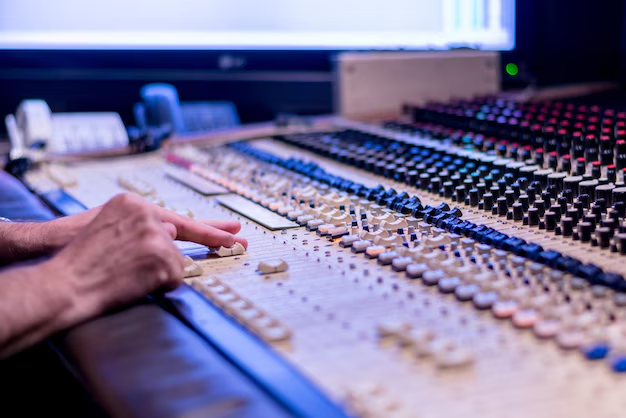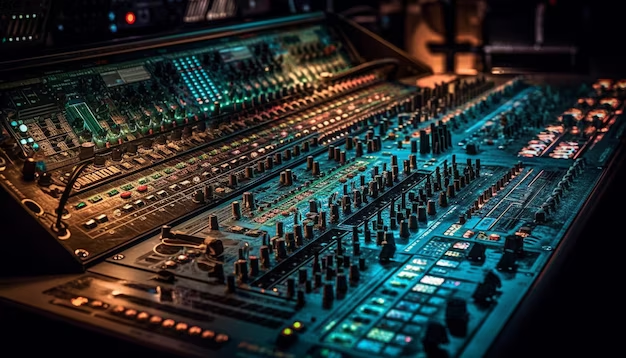Understanding Signal Flow: A Beginner's Guide to Audio Consoles

Audio consoles are an essential aspect of sound production; therefore, if you are into audio engineering, like playing musical instruments, or are also interested in tampering with sound, you need to know how these consoles work, including signal flow. Audio mixing consoles, also called sound or mixing desks or soundboards, play a central role in delivering sound in the live, recording, and broadcast industries. About the topic, this guide to audio consoles will describe what they are and how to apply them, and it will also provide a guide to purchasing sound mixers. Also, there are some outlined frequently asked questions associated with these services to prevent the occurrence of misunderstandings and make the right choices.
What Are Audio Consoles?
An audio console is an equipment that allows audio signals to be mixed and distributed and can modify specific parameters such as the dynamic, tone, and volume. Such signals could be from microphones, an instrument, or a record from a previous take of the song. This is essential so that when you are ready to mix your levels or add some final effects or effects on groups of tracks, you have control over the final product you hear from your console. It is important to note that audio consoles are also available in various sizes and shapes, from small mixers for home recording to large format ones for professional recording/performing use.
Read More: 7 Resounding Reasons Why (GOOD!) Audio Matters
How to Use an Audio Console
Understanding Signal Flow
Signal flow lies at the core of all the tasks that require working with an audio console. Signal flow, or signal chaining, is the route the audio signal takes through a circuit before it is produced as an output. This process goes through several phases: preamplification, equalization, routing, and mixing.
- Inputs: Plug all microphones, instruments, or playback devices into the console input channels. Because the signal in every input channel would typically be shallow, each channel usually has a pre-amplifier to bring the signal up to a more easily working level.
- Channel Strips: Every input is represented by a channel on the console, with resultant sections that allow the user to adjust and control the Gain, Equalization, Aux Sends, Pan, and Faders. Use the output set to bring a level of input signal to an optimal level.
- Equalization (EQ): Perform side EQ control over the sound quality character to enhance tone. When operating sensitivity adjustments, you can increase or decrease the specified frequency ranges, which will help balance the sound.
- Aux Sends: These are utilized in a manner that they can feed a part of the signal to external effects processors or monitoring mixes.
- Panning: Pan controls are tools that determine where the signal is positioned within the stereo field to appear more expansive.
- Faders: The faders should be used to regulate the volume for each channel of the mix. If possible, dividing instruments or vocals into sub-groups depending on their expertise is also recommended for better control.
- Master Section: This section comprises the main output faders, bus output, and the master controls section. It is where all your' shooting in the dark' messages end up before being transmitted to the output section, for instance, the speaker or the recorder.
Read More: Finding the Perfect Audio Setup for Your Event
Step-by-Step Guide to Using an Audio Console
- Connect Your Sources: Connect the microphones, instruments, or playback devices to the required input channels.
- Set Gain Levels: Turn down the gain knobs to make the signal presenting to the microphone reasonably loud but not clipping.
- EQ the Signals: Adjust the selected band frequencies up or down using EQ controls to balance the volume of each channel.
- Set Aux Sends: Set up the aux sends for effects or the HF and LF monitor mixes.
- Pan and Balance: B ri aly balance the levels across all channels and achieve a balanced stereo output.
- Mix with Faders: You want to adjust the channel faders to establish the desired input volumes to create balance and coordination.
- Master Output: This allows altering the level of tracks or the general level of the whole mix via the master faders.
Sound Mixers Buying Guide
When buying a sound mixer, consider the following factors to find the best fit for your needs:
- Number of Channels: The number of required input channels depends on the number of inputs you would connect to the mixer.
- Analog vs. Digital: Have an analog console that will give that physical touch of the knobs for mixing and a digital one that will provide more control alternatives, plus it is compensated with effects.
- Features: Search for essential features like phantom power for condenser microphones, including effects and appropriate aux sends.
- Portability: Here, one has to consider the mixer's size and weight if it will be transported from one location to another often.
- Budget: Decide the amount you are willing and able to spend on mixers and compare manufacturers offering the most significant value.
Read More: Buying Used Pro Audio Equipment: A Know-It-All Guide
Overall, there are many differences between good and finer audio consoles, and understanding these consoles can significantly enhance the quality of audio production. A positive difference is felt with the help of a console, whether it is a live show or studio recording. That's the best introduction to what will hit you if you are ready for the next level in the sound game. For more information, please visit our Sound Mixers Buying Guide, which features our top preferred audio consoles. Talk to us at GearSource to find the best audio consoles and sound mixers for your specific arrangement!
FAQs
- What is the difference between an audio console and a mixer?
An audio console and a mixer are the same things, though audio consoles tend to be much larger and more complex than mixers. These two terms are related because they describe a device employed to manage several audio signals.
- Can I use an audio console for live sound and recording?
Indeed, it is true that most audio consoles can also be used to perform live sound and for recording purposes. Nevertheless, particular kinds have focused features for one use, so review the features and decide if they will suit your needs.
- Do I need an audio console if I already have an audio interface?
This recording tool provides essential elements of inputs and outputs, and its significant advancement from an audio interface is that an audio console gives overall control of more inputs and outputs and is appropriate where several are required.
- What is phantom power, and why do I need it?
Phantom power is a feature that provides voltage to condenser microphones, which are types of microphones that need exterior power. It is mandatory if you are using condenser mics in a recording booth.
- How do I prevent feedback when using an audio console?
To avoid feedback, check the position of the microphones, employ equalization to attenuate the frequency bands, and calibrate the levels of gain that are beyond necessity.

